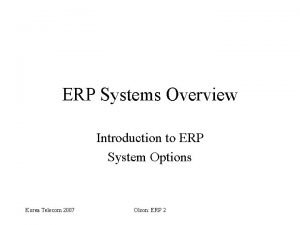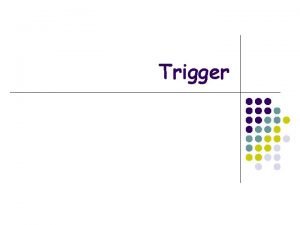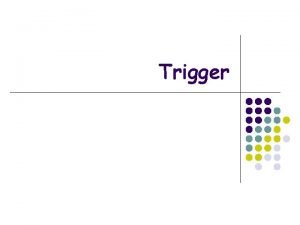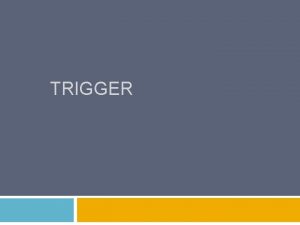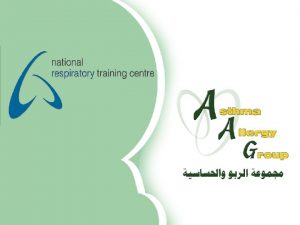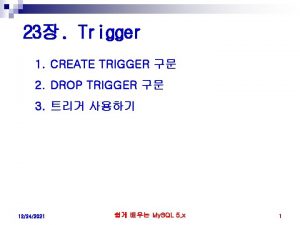Trigger system WG meeting 1 Trigger system overview







- Slides: 7

Trigger system WG meeting 1. Trigger system overview 2. PMT signal treatment for triggering 3. White Rabbit system’s overview 4. Trigger & clock distribution 5. Trigger simulation study 6. Discussion and planning 7. Ao. B A. Guglielmi G. L. Raselli D. Torretta, A. Fava, G. Meng G. Petrillo et al. ICARUS Coll. Meeting September 18 th 2018

Expected event rates in ICARUS-T 600 l BNB facts - 5 1012 pot/spill extracted in ~1. 6 ms, 5 Hz repetition rate: ~1 event over 35 spills is expected in ICARUS: Ø ~1 neutrino interaction in T 600 LAr-TPC per 180 spills; Ø ~1 beam-associated event every 210 spills, mainly from muon beam halo/ interactions in the material surrounding T 600; Ø ~1 in-spill cosmic event every 55 spills. l Nu. MI Off-Axis facts - 4 1013 pot/spill in ~8. 6 ms, 0. 53 Hz repetition rate: ~ 1 event over 23 spills is expected in ICARUS mainly due to in-spill cosmics, ~ 1 neutrino interaction/280 spill; l Globally a ~0. 2 Hz physical event rate inside the proton pulse time windows, is roughly expected corresponding to ~ 4 PB of data for the total 6. 6 10 20 pot exposure if the full ICARUS-T 600 detector is read-out (~70 MB event size); l The trigger system would select genuine n interactions while rejecting background and noise. For this purpose a staged level trigger has to be adopted, aiming at progressively reducing the data amount from the front-end buffers to the offline storage. th 2018 4 1 y a M , FNAL g n i t e e M ICARUS Slide# : 2

Trigger system overview l ICARUS Trigger will be initially based on the recognition of the PMT signals within the gate of BNB/Nu. MI beam extraction. A careful study of neutrino interactions vs cosmic rays is mandatory in order to extract neutrino signals from cosmogenic background using CRT information and possibly then the bunched beam structure. l The adopted FPGA programmable tables in the Trigger layout would allow to implement step by step complex trigger logics, initially set according to MC events, then tuned on real events to match the actual experimental conditions. l Furthermore this would allow to test directly different trigger configurations to gradually reduce the recorder event rate from 5 Hz of BNB spill to <1 Hz, depending from the detector condition in term of noise (~0. 2 Hz rate expected from the cosmics + n-int + beam halo events inside the beam spill). l T 600 – BNB clock synchro: guarantee at ~50 ps level by White Rabbit system. l The preparation of the Trigger system will involve both the technical aspects of the programming of trigger boards and of as well as of dedicated analysis of MC events at first and then of real data. The study of both beam and cosmic MC events is crucial to start implementing a trigger algorithm! Slide# : 3

ICARUS Trigger system - 1 l 90 PMTs/TPC are connected to 6 CAEN V 1730 B boards which produce a set of discriminated output signals in terms of OR/AND of pairs of adjacent PMTs for majority trigger logic. l Trigger logic based on the multiplicity/topology of fired PMTs in each TPC will be implemented in the FPGA programmable tables according to expected event features (MC event analysis). l Furthermore, according to the low energy of BNB/Nu. MI beams, n interactions are expected to be mainly spatially confined in a small ~ 3 m long section of T 600, involving ~ 15 neighboring PMTs l Therefore the analogue sum signal of 15 PMT signals in a ~ 3 m detector slice can be included in the trigger scheme to identify the neutrino interaction. l According to ICARUS experiment at LNGS this would increase the Trigger recognition capability rejecting at same time detector noise, and possibly identifying the interested detector region. Slide# : 4

ICARUS trigger system - 2 l Based on NI PXIe instrumentation: PXIe-8135 CPU, a Real Time (RT) controller, SPEXI board by Incaa Computers and 3 NI boards (PXIe-7820 R) for the PMT Trigger and the General Trigger: Ø RT controller: implements all features for ICARUS Trigger NI Crate communication with DAQ, monitoring of available buffer/veto generation; R T Ø SPEXI: synchronizes timing of whole 8 7 7 7 detector, generates TT-Link signal for TPC C 8 8 8 1 readout, Clock & Reset to PMT readout, o S 2 2 2 3 n P 0 0 0 and handles beam extraction messages; 5 t E R R R r X Ø 2 PMT trigger 7820 boards: generate a CPU o I PMT General PMT Trigger & the start to pulse digitizers l Trigger for the PMT activity recording in l e correspondence of interactions in LAr as r detected by PMTs in each T 300; Ø General Trigger 7820 board: combines PMT Dedicated algorithms will be Trigger with SPEXI signal to generate a implemented in PMT Trigger Logic Global Trigger in coincidence with beam to select n events from cosmics. extraction from BNB/Nu. MI (early warning). Slide# : 5

PMT DAQ + Trigger Test Bench/studies l Test bench set-up for digitizers & FPGA programming including 7820 + SPEXI boards + 8135 CPU + LVDS-TTL level-shifter to: Ø Programming of trigger logics and measuring the occurring rates of different configurations in terms of coincidence/majority of PMTs; Ø Programming SPEXI to generate TT-Link, Clock & Beam Gate signals to be combined in the PMT trigger; Ø Clock distribution/synchronization of different boards; timing resolution of different PMT ‘s lit by the laser to optimize the PMT time alignment. l Test of DAQ, timing of event building: gradually implementing the DAQ/trigger systems with LAr test facility at CERN, 50 l LAr-TPC + 10 PMTs in LAr dewar. l Firmware for programming FPGA: Ø VHDL codes for generating TT-Link and clock are ready for test (Padova); Ø VHDL codes for reception of beam Early Warning in preparation (Padova); Ø Lab. VIEW driver for SPEXI/FMC-DIO hardware in preparation (Pavia). l Software for White Rabbit calibration/configuration is being prepared by FNAL group. Latency tests and beam counter signal tests in progress. l Planned study of both beam and cosmic MC events from point of view of PMT response according to Software WG activities. Slide# : 6

Planning for implementation of Trigger system A tentative time schedule: to be discussed Sept ->: study of both cosmics/ n interactions MC events Oct: test of beam signal receiving/decoding (SPEXI board) Sept- Jan ‘ 19: test of DAQ, timing of event building, LAr-test facility CERN Feb ‘ 19: test of trigger gate generation with beam signals Mid Feb: DAQ/Trigger ready for installation; test-pulse on 1 st T 300 March: completion of trigger installation on 2 nd T 300 Mid June: activation/commissioning of T 600 Trigger/data taking with c-rays, BNB and Nu. Mi beams; Mid July: post commissioning run: detector calibration and trigger studies; Slide# : 7





